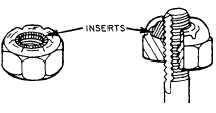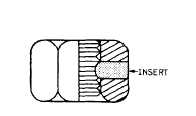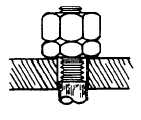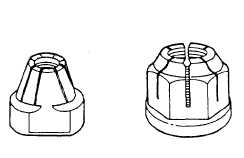Figure 9-65 .—Plastic ring nut.
Figure 9-67.—Jam nuts.
Figure 9-66.—Nylon insert nut.
Plastic Ring Nuts
Plastic ring nuts (fig. 9-65) deform the plastic
insert when they are installed. The resilient
plastic material is forced to assume the shape
of the mating threads, creating large frictional
forces.
Nylon Insert Nuts
Nylon insert nuts (fig. 9-66), have plastic
inserts (plugs) that do not extend completely
around the threads. They force the nut to the side,
cocking it slightly. This produces frictional forces
on one side of the bolt thread. Although the
plastic insert locks without seating, proper
torque applied to the nut stretches the bolt,
creating clamping forces that add to the locking
abilities of the nut. Before reusing nylon insert
nuts, check the inserts. If worn or torn, discard
the nut. Install the nut (on clean lightly lubricated
threads) finger tight. If you can install the nut to
the point where the bolt threads pass the insert
without a wrench, discard the nut and use a new
one.
Jam Nuts
You should install jam nuts (fig. 9-67) with
the thinner nut to the working surface and the
thicker nut to the outside. The thin nut is
deformed by the wider nut and pressed against
the working surface and threads.
Figure 9-68.—Spring nuts.
Figure 9-69.—Spring beam nuts.
Spring Nuts
Spring nuts (fig. 9-68) lock by the side grip
on the bolt. When tightened, the spring nut
flattens, or straightens, a spring section. Many
types of spring nuts use curved metal springs,
bellows, and coil springs. All spin on and off
without locking until the pressure against the
working surface straightens the spring.
You should always consult equipment
manuals for the proper torque value. Be sure
threads are always clean and lightly lubricated
with the proper lubrication. Discard any with
damaged threads.
Spring Beam Nuts
Spring beam nuts (fig. 9-69) are formed with
a light taper in the threads toward the upper
9-46









